GALAXIDI . . .
Galaxidi (Γαλαξίδι, until 1940 Γαλαξείδιον) is a small town and since 2011 a municipal district of the municipality of Delfi in central Greece. The village is located in a bay of the Gulf of Corinth southwest of the Oracle of Delphi, south of Amfissa and southwest of Itea.
In ancient times, the place was called Chalaion (ancient Greek Χάλαιον) or Chaleion (Χάλειον) and was a town of the Western Lokrians on the border with Phocis. Galaxidi achieved importance and prosperity in the 18th and 19th centuries.
During that time, Galaxidi was the seat of one of the most powerful merchant fleets in the Mediterranean. The witnesses of this golden age, the typical captain's houses, have been preserved to this day and are maintained and cared for by their often direct descendants. On the hill between the two harbours of Galaxidi rise two magnificent 18th century churches.
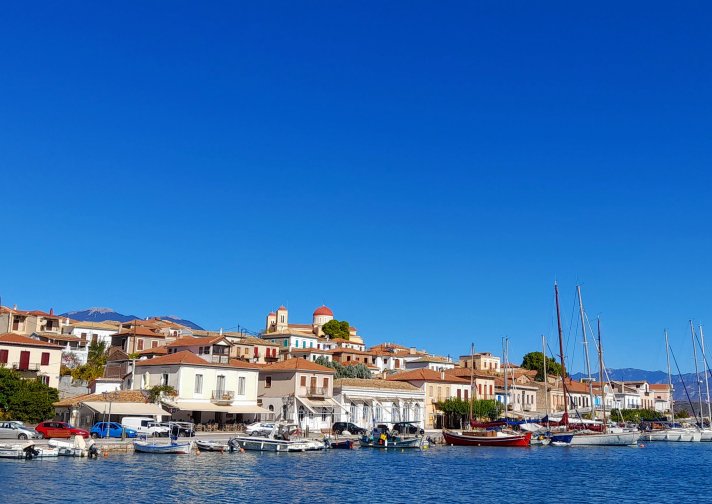 |
 |
View from Galaxidi Captain's house at the harbour
Name
The name Galax(e)idi first appears between the 6th and 9th centuries AD. There are many versions of the origin of the name. Linguistic studies agree that the toponym comes from the medieval phoneme γαλατσίδα (herbaceous plant common in the area), which goes back to the later form γαλακτίς, -ίδος, so that the etymologically correct spelling is -ι-: Γαλαξίδι. The traveller Dodwell claimed that the name was derived from the words γάλα and οξώδης ("similar to oxos, sour"). The view that it was derived from the words γάλα and ιξός (from the milky, thick, sticky sap that oozes when the stem is injured) is morphologically untenable. In the late Renaissance, it was widely believed that the place name came from the Galaxidi family, who owned land in the area. It was even rumoured that Galaxides was the Byzantine chief of this small area and rebuilt the destroyed city. In reality, however, the surname Galaxides derives from the toponym Galaxidi. There is also a legend about the origin of the name about a mermaid called Galaxa. Prometheus had fallen in love with her and therefore stole her.
Ancient times
In ancient times, the area of Galaxidi was inhabited by the Ozoloi or Hesperian Locrios in the 8th century BC. The ancient city of Chalaion was located in this place. Chalaion was one of the most important cities because the sanctuary of Apollo was located here. Its inhabitants were mainly engaged in shipping and thus in trade. It is worth noting that until recently scholars believed Galaxidi to be the ancient Oeanthi or Oeanthia. This view is of course no longer accepted today, as Pausanias mentions that Oianthi was in the area of Nafpaktos. Polybius also counts it among the cities of Aetolia.
The area is characterised by a continuous presence with important finds already from the Prohelladic period (Anemokambi, Pelekaris, Kefalari, the island of Adigalia). The Mycenaean settlement at Villa is significant, as is the fortified geometric settlement on the hill of Agios Athanasios (c. 700 BC). In the Archaic and Classical periods (7th-4th century BC), the religious and administrative centre of the city developed in Agios Vlasis alongside the settlement in Villa. Around 300 BC, the present site was settled and the fortress wall was built. Perhaps by this time the Etholian community had already gained control of the town and fortified it. Chalaion was inhabited and flourished until the 2nd century AD. The British Museum houses two bronze inscriptions from the 5th century BC, documenting the treaty between Ethiopia and Chalaion. The same museum houses 97 other bronze vessels and utensils, while archaeological artefacts from Galaxidi are now held in 15 museums around the world. Finds from Chalaion and the surrounding area are on display at the Galaxidi Archaeological Museum.
Byzantine period
Galaxidi was first mentioned in documents in the 10th century. During the reign of Basil II, Galaxidi was conquered by the Bulgarians of Tsar Samuel in 981 or 996, which had dramatic consequences for the inhabitants. The inhabitants left the city and settled on the islands of the Gulf of Itea, and Galaxidi was uninhabited for the next 50 years. The misfortune for the city of Galaxidi did not end there. In 1054, an epidemic wiped out many of the inhabitants, and in 1064, a raid by the Oguz Turks led to them being forcibly expelled from the city for two years.
Galaxidi was sacked by the Normans in 1081 and again in 1147. After the Fourth Crusade, Galaxidi initially belonged to the autonomy of Salona, but was reconquered by the despotate of Epirus around 1211. After 1269, the city came under the control of the Lords of Thessaly, who had their seat in Hypati. In 1311, the city was conquered by the Catalans and came under the authority of the Duchy of Athens.
The city was first occupied by the Ottomans in 1394, but was recaptured soon after by Theodore I Palaiologos. In the years 1403/04, it briefly fell to the Knights of St. John. The city's castle, of which not even a trace remains today, was strengthened in 1447/48 by Constantine Kantakouzenos, but this did not prevent the final capture by the Ottomans soon after.
Turkish rule
The era of Turkish rule began in 1446. In 1494, the seat of the Bey was transferred from Salona to Galaxidi. The first appointed Bey was Hatzi-Babas. Finally, in 1502, the seat returned to Salona by order of the High Gate. It is worth noting that not a single Turk resided in Galaxidi during the entire period of Turkish occupation.
In 1655, Douratzibey came into conflict with the inhabitants of Galaxidi for a trivial reason. The ensuing naval battle ended in defeat for Duratzibey, who, however, swore revenge. On Easter of the same year, he attacked unexpectedly and conquered Galaxidi. This misfortune caused the inhabitants of Galaxidi to flee to the mountains. Only after Duratzibey's death in 1669 did they return to the destroyed Galaxidi.
The heyday of Galaxidi's navy began in the period from 1720 to 1730, i.e. immediately after the Treaty of Pazarovich (1718). In 1774, after the Treaty of Kiotschuk-Kainardschi, most Galaxidian ships sailed under the Russian flag. A great personality of the independence struggle played a prominent role in the development of shipping: Ioannis Papadiamantopoulos. Papadiamantopoulos had concentrated trade in the Peloponnese and throughout western Greece. In order to free himself from the central Greek navy, he began to build ships in Galaxidi. In 1803, the Galaxidi fleet numbered 50 ships. The most frequent trading ports of the Galaxidi ships were: Marseilles, Constantinople and various other ports in Spain and Italy.
Revolution of 1821
The first consultations for the start of the revolution in Galaxidi had begun at the beginning of March on the initiative of Ioannis Papadiamantopoulos. Bishop Isaias of Salona, Odysseus Androutsos, Panourgias, Yannis Gouras and the local prelates attended the meeting. On 26 March, a group of 300 men set out for Amfissa. It is worth noting that this was the first town in central Greece to raise the flag of liberation. The captains and merchants immediately offered their ships in support of the fatherland, while many Galaxidians rushed to fight in the Hani of Gravia. To further strengthen the revolution, they published a newspaper of sorts ("The First of the Revolution"). What is certain is that the contribution of Galaxidi to the liberation struggle of 1821 cannot be disputed by anyone.
The disasters of Galaxidi
During the liberation struggle, Galaxidi experienced three major disasters.
The first catastrophe
On September 8, 1821, Ismail Bey's fleet sailed into the Gulf of Corinth with 30 armed brigs and 2 frigates. On September 22, an English ship led the Turkish fleet to Galaxidi. The Galaxidians and 200 men from Panourgia defended themselves vigorously. However, during the night the men of Panourgia retreated as they did not have the experience to deal with the naval cannon fire. The inhabitants saw the gap in the town's defences and the inadequacy of the fighters and abandoned Galaxidi. On the morning of September 23, the Turks entered the city and destroyed it. In the harbour they found 90 ships, of which 13 were warships and the rest small merchant vessels. According to historians, the chances of saving Galaxidi were slim, as the city fell victim to the first political conflicts. The destruction was due to the Galaxidians' inertia and the interest-driven tactics of the politicians of the time.
The second and third catastrophe
In May 1825, Kioutachis attacked Galaxidi and destroyed it to cover his back so that he could safely besiege Messolonghi. Of course, this second destruction was less painful because Galaxidi's ships were not anchored in the harbour. But in November of the same year, an even worse disaster followed, this time at the hands of Ibrahim, who managed to capture ships and take many women and children captive, who were sent to Egypt as slaves. After this catastrophe, the inhabitants fled and settled in Hydra, Corinth, Loutraki, etc. Only much later did the government manage to bring back some Greek prisoners from Egypt.
1940-1944
Like the other Greek towns, Galaxidi sent many young men to the front. The first occupation troops settled on May 15, 1941 and quickly occupied the kindergarten, the primary school, the Koutsoulieri house, the Drosopoulou house and the Platoni house. The majority of the soldiers were Italians, as the administration of Central Greece had been taken over by the Italian authorities. In the following days, the active officers of the army were arrested[, while the Italians demanded that the inhabitants hand in their weapons. In January 1942, the Italians were relocated to Itea. In March of the same year, the two Italian spies disappeared, whereupon the Italian commander intervened and gave the inhabitants of Galaxidios an ultimatum of 48 hours to return home unharmed. The ultimatum expired and the Italians threatened the town with arson. However, the timely intervention of Loukas Platoni, the head of the municipality, and Ioannis Andreopoulos, the captain, saved the town from certain destruction. The following years were extremely difficult for the inhabitants of Galaxidi, as hunger had impoverished them.
The most unfortunate year for Galaxidi was 1944. On February 7, 1944, the Germans approached threateningly the Villa Zacharia, where some English officers were staying. At the same time, they arrested every passer-by who crossed their path. In the ensuing confusion, seventeen-year-old Theodoros Barliakos was killed. After unsuccessfully pursuing the English officers, the Germans went to the market where they had gathered about a hundred Galaxidians. Of these, they arrested eleven people who were sent to Athens, except for three who were deported to Germany. In 1944, two more incidents occurred in which Galaxidians were threatened. The first incident occurred on March 13, when partisans captured a German supply ship that was anchored in the harbour due to bad weather. The two German escort ships were also captured and the crew taken prisoner. The commander threatened the inhabitants of the town with total destruction if they did not return the prisoners within three days. However, an accidental wounding of the commander led to his relief and thus the salvation of the town. A few months later, in July, about 800 Germans surrounded the town with the intention of capturing the English officers. In the end they failed, but in revenge they arrested 15 Gallaxidians, who were released after 2-3 months following the intervention of the community leader. The last incident occurred in August 1944, when the Germans cut Galaxidi off from Red Cross supplies.
By the end of the Second World War, Galaxidi had suffered 421 casualties.
Maritime City
The golden age of prosperity for Galaxidi was between 1829 and 1912. Of course, the inhabitants of Galaxidi had already begun to engage in shipping with great success during the time of the Turkish occupation. The year 1774 can be mentioned as the starting point for the development of shipping, when the contract between Kioutsuk and Kainardzi was signed. Ioannis Papadiamantopoulos played an important role in this. In 1803 Galaxidi had 50 ships, making it one of the five cities with the most ships in Greece.
After the revolution and after the city had recovered from the disasters, shipping began to grow again. In the three years from 1838 to 1840, there were an average of 21 shipyards per year in Galaxidi. The city's shipyard was able to compete with foreign shipyards and was more profitable, as it cost half as much to build a ship as it did in foreign shipyards. Merchant ships plied the Black Sea, the Sea of Azov, the Danube, the Mediterranean, England, etc. The municipality tried to inspire young people for trade and navigation by appropriate measures and therefore founded a nautical school where great personalities like Efthimios Kavassilas taught. In the great ports of Europe, namely Livorno, Odessa, Trieste, Marseilles, Nice, etc., numerous Gallaxidi nautical agencies were founded to coordinate their activities. As demand increased, more and more shipyards were founded. In 1860, there were an estimated 300 Gallaxidi ships. Shipping continued to increase until 1900, but by the beginning of the 20th century the number of merchant ships was declining. A typical example is that in 1892 the Galaxidi still had 126 sailing ships, but by 1903 there were only 92. In contrast to the decline in trade, the Galaxidi steamships managed to survive until the 1930s.
The decline of shipping was followed by the demographic problem, which appeared almost immediately. The main reason for this was that the inhabitants of Galaxidi, who usually worked as captains or sailors on foreign ships, had to move to Piraeus, where all the shipping companies were concentrated, because of the shortage of jobs.
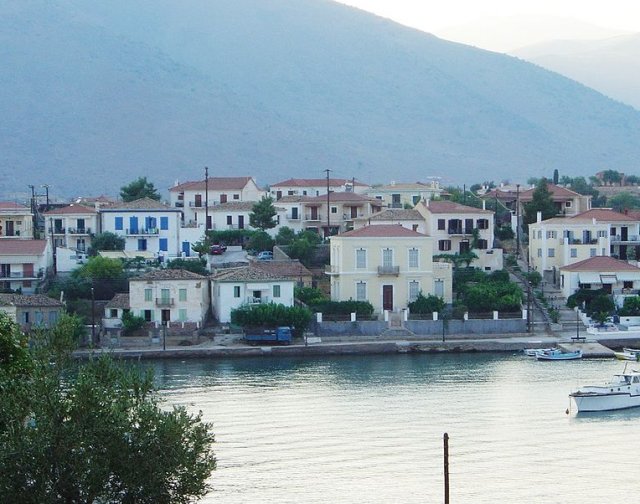 |
 |
Port of Galaxidi View from Galaxidi
Places of interest
Church of St. Nicholas
The present church of St. Nicholas is built on a pagan sanctuary. In the 7th century the first church was built, while in 1800 the inhabitants of Galaxidi started building a larger church at their own expense. In 1900, the present church was built. The decision was taken by the mayor Konstantinos Papapetros in 1896 and the architects were Germanos Hager and Konstantinos Papapetros. The church is built in Byzantine style with two bell towers and a dome. It has three naves and in the bell tower is the large town clock, donated in 1908 by the brothers Nikolaos and Pavlos Sidiropoulos. The church's wooden iconostasis is a characteristic example of woodcarving. It was created in the 1840s to 1850s and is in the Baroque style.
Monastery of the Redeemer
The monastery is located 300 m above sea level on a nearby hill south of Galaxidi. The church existed in the early years of Christianity, but was destroyed in a devastating earthquake in the early 13th century. At the request of the inhabitants, the despot of Epirus, Duke Michael II Angelos Komnenos, had a new chapel built around 1250, dedicated to the Transfiguration of Christ the Saviour. The church is a single-nave, cruciform church with a rectangular floor plan. In 1750 a men's monastery was founded, but the earthquake of 1756 destroyed the monastery's Catholic church and cut off the water supply, so it was abandoned. In 1927, some monks settled, but they left 5 years later. The basic reconstruction of the monastery took place in 1989 at the instigation of the Metropolitan of Phokis Athenagoras. In 1990, the nun Isidora was appointed to look after the monastery and the surrounding area. In 1864, the "Chronicle of Galaxidi" by Konstantinos Sathas, written by the monk Efthymios in 1703, was found in a crypt of the destroyed church.
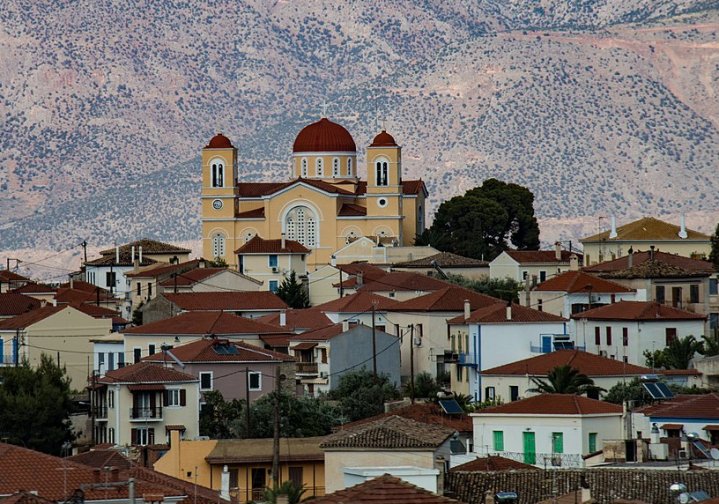 |
 |
Church of St. Nicholas Monastery of the Redeemer
Church of St. Paraskevi
Church of St. John
The small chapel is located on the top of the Pera Panda hill, from where there is a magnificent view of the sea.
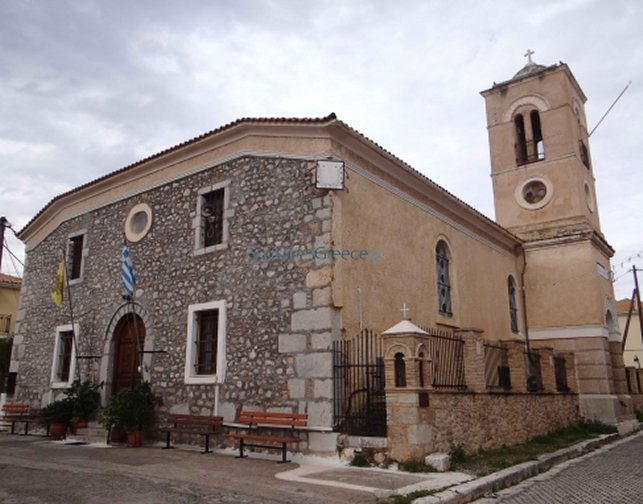 |
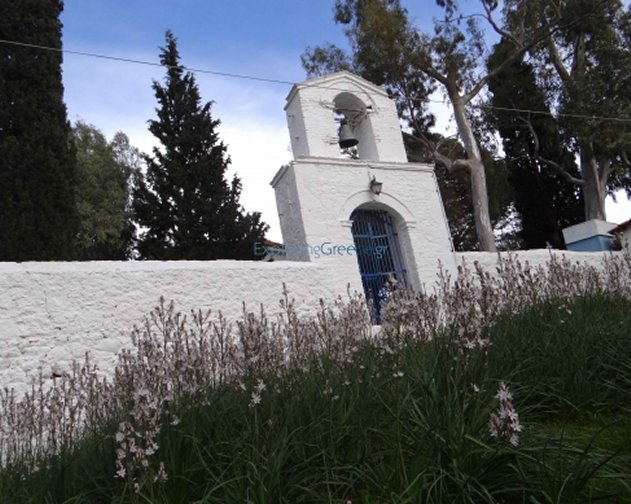 |
Church of St. Paraskevi Church of St. John
Kapodistrias School Galaxidi
The Kapodistrias' School is located in Koukounas and is one of the oldest schools. It was built under Ioannis Kapodistrias at the expense of the municipality, which contributed 4,389 piastres, and the government. It served as a primary school until 1932, when it was abandoned and sold by the school tax authorities. It was declared a listed building by ministerial decree.
Maritime and Ethnological Museum
The Maritime and Ethnographic Museum is housed in a building erected in 1870 under Mayor Chardavella. Since 1932 it has housed the Maritime Gallery. In addition to the Maritime Gallery, the Maritime and Ethnographic Museum also houses archaeological finds from the region. This archaeological collection was established in 1932, but many pieces were lost during the occupation. Today, the collection comprises about 300 exhibits. Nicolaos Mamas, who financially supported the excavations of the museum, Ioannis Threpsiadis, who carried out many excavations, Petros Themelis, the curator of the antiquities of Delphi, etc. played an important role in the foundation of the museum.
The nursery school
The nursery school was built in 1880 under the mayorship of Nikolaos Loukeris. It was used as a girls' school until 1929, after which it served as a theatre. For many years the building stood empty, and to prevent it from falling into disrepair it was auctioned off by the school authorities in 1949. The couple Efthimia and Panagiotis Koulombourou bought it and donated it to the municipality of Galaxidi. Since 1992, it has been a listed building because of its architectural and historical significance.
The mansions of Galaxidi
Most of the city is made up of villas that recall the city's wondrous past, many of which are listed monuments. The architectural expression was influenced by the inhabitants' profession as seafarers who, as worldly men, brought building materials and craftsmen from abroad. The first villas were built in 1850, and the European influence is unmistakable. Many houses even have ceilings designed by Italian painters. Some of the villas that stand out for their style are the Bourzeiko of Katsoulis, the Dedousaiko of the shipowner Dedousis, the Moscholaiko, the Nineiko of P. Tsounas, etc.